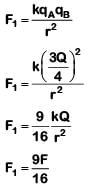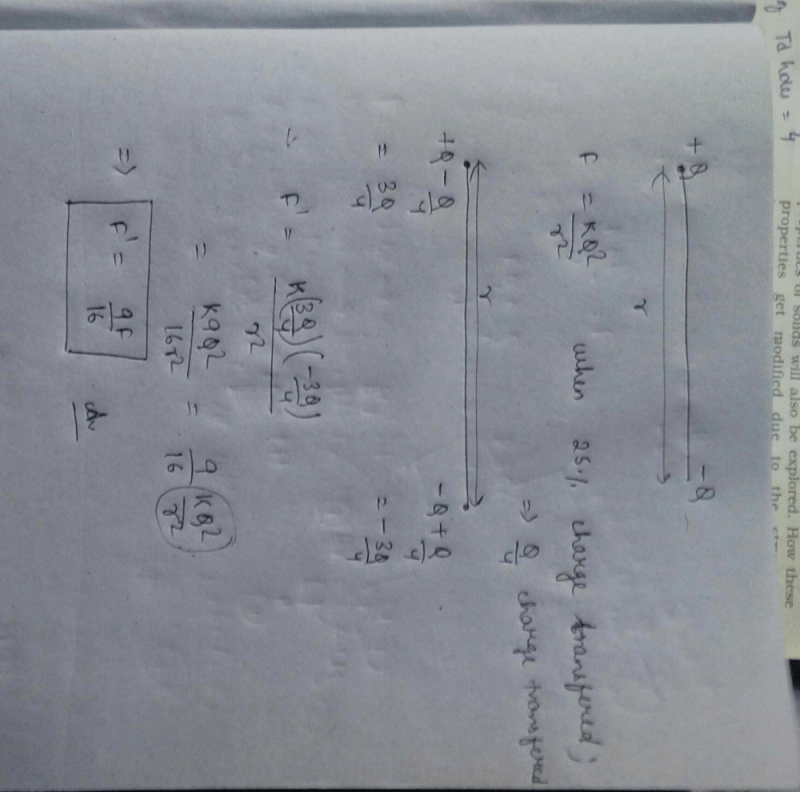NEET Exam > NEET Questions > Two point charges A and B, having charges +Q ...
Start Learning for Free
Two point charges A and B, having charges +Q and –Q respectively, are placed at certain distance apart and force acting between them is F. If 25% charge of A is transferred to B, then force between the charges becomes :
- a)F
- b)9F/16
- c)16F/9
- d)4F/3
Correct answer is option 'B'. Can you explain this answer?
| FREE This question is part of | Download PDF Attempt this Test |
Verified Answer
Two point charges A and B, having charges +Q and –Q respectively...


If 25% of charge of A transferred to B then


Most Upvoted Answer
Two point charges A and B, having charges +Q and –Q respectively...
-Q respectively, are placed at a distance d apart from each other. The electric field at a point P on the line joining the two charges depends on the distance of the point P from each of the charges.
Let the distance of point P from charge A be x, and the distance from charge B be (d-x). By Coulomb's law, the electric field due to charge A at point P is given by:
Ea = (1/(4πε0)) * (Q/x^2)
where ε0 is the permittivity of free space. Similarly, the electric field due to charge B at point P is given by:
Eb = (1/(4πε0)) * (-Q/(d-x)^2)
The negative sign in front of Q indicates that the electric field due to charge B is in the opposite direction to that due to charge A.
The total electric field at point P is the vector sum of the electric fields due to the two charges:
E = Ea + Eb
We can write this as:
E = (1/(4πε0)) * [(Q/x^2) - (Q/(d-x)^2)] * ê
where ê is a unit vector in the direction of the electric field. Note that the electric field is a vector quantity, so we need to specify both its magnitude and direction.
The direction of the electric field is from charge A to charge B, since this is the direction in which a positive test charge would be pushed. The magnitude of the electric field depends on the distances x and (d-x), as well as the charges Q and -Q.
We can simplify the expression for E by using the fact that x + (d-x) = d:
E = (1/(4πε0)) * [(Q/d^2) * (2x - d)] * ê
This shows that the electric field at point P is proportional to the difference between the distances of the point from the two charges. If the point P is equidistant from the two charges (i.e. x = d/2), then the electric field is zero. This is because the electric fields due to the two charges cancel out at this point.
If we move the point P towards one of the charges, the electric field due to that charge becomes stronger, while the field due to the other charge becomes weaker. The electric field at point P is strongest when it is very close to one of the charges, and weakest when it is in the middle of the two charges.
Overall, the electric field due to two point charges is a simple example of how electric fields can be added together to find the total field at a point. This principle can be extended to more complex systems of charges, by adding up the electric fields due to each individual charge.
Let the distance of point P from charge A be x, and the distance from charge B be (d-x). By Coulomb's law, the electric field due to charge A at point P is given by:
Ea = (1/(4πε0)) * (Q/x^2)
where ε0 is the permittivity of free space. Similarly, the electric field due to charge B at point P is given by:
Eb = (1/(4πε0)) * (-Q/(d-x)^2)
The negative sign in front of Q indicates that the electric field due to charge B is in the opposite direction to that due to charge A.
The total electric field at point P is the vector sum of the electric fields due to the two charges:
E = Ea + Eb
We can write this as:
E = (1/(4πε0)) * [(Q/x^2) - (Q/(d-x)^2)] * ê
where ê is a unit vector in the direction of the electric field. Note that the electric field is a vector quantity, so we need to specify both its magnitude and direction.
The direction of the electric field is from charge A to charge B, since this is the direction in which a positive test charge would be pushed. The magnitude of the electric field depends on the distances x and (d-x), as well as the charges Q and -Q.
We can simplify the expression for E by using the fact that x + (d-x) = d:
E = (1/(4πε0)) * [(Q/d^2) * (2x - d)] * ê
This shows that the electric field at point P is proportional to the difference between the distances of the point from the two charges. If the point P is equidistant from the two charges (i.e. x = d/2), then the electric field is zero. This is because the electric fields due to the two charges cancel out at this point.
If we move the point P towards one of the charges, the electric field due to that charge becomes stronger, while the field due to the other charge becomes weaker. The electric field at point P is strongest when it is very close to one of the charges, and weakest when it is in the middle of the two charges.
Overall, the electric field due to two point charges is a simple example of how electric fields can be added together to find the total field at a point. This principle can be extended to more complex systems of charges, by adding up the electric fields due to each individual charge.
Free Test
FREE
| Start Free Test |
Community Answer
Two point charges A and B, having charges +Q and –Q respectively...

Attention NEET Students!
To make sure you are not studying endlessly, EduRev has designed NEET study material, with Structured Courses, Videos, & Test Series. Plus get personalized analysis, doubt solving and improvement plans to achieve a great score in NEET.

|
Explore Courses for NEET exam
|

|
Similar NEET Doubts
Two point charges A and B, having charges +Q and –Q respectively, are placed at certain distance apart and force acting between them is F. If 25% charge of A is transferred to B, then force between the charges becomes :a)Fb)9F/16c)16F/9d)4F/3Correct answer is option 'B'. Can you explain this answer?
Question Description
Two point charges A and B, having charges +Q and –Q respectively, are placed at certain distance apart and force acting between them is F. If 25% charge of A is transferred to B, then force between the charges becomes :a)Fb)9F/16c)16F/9d)4F/3Correct answer is option 'B'. Can you explain this answer? for NEET 2024 is part of NEET preparation. The Question and answers have been prepared according to the NEET exam syllabus. Information about Two point charges A and B, having charges +Q and –Q respectively, are placed at certain distance apart and force acting between them is F. If 25% charge of A is transferred to B, then force between the charges becomes :a)Fb)9F/16c)16F/9d)4F/3Correct answer is option 'B'. Can you explain this answer? covers all topics & solutions for NEET 2024 Exam. Find important definitions, questions, meanings, examples, exercises and tests below for Two point charges A and B, having charges +Q and –Q respectively, are placed at certain distance apart and force acting between them is F. If 25% charge of A is transferred to B, then force between the charges becomes :a)Fb)9F/16c)16F/9d)4F/3Correct answer is option 'B'. Can you explain this answer?.
Two point charges A and B, having charges +Q and –Q respectively, are placed at certain distance apart and force acting between them is F. If 25% charge of A is transferred to B, then force between the charges becomes :a)Fb)9F/16c)16F/9d)4F/3Correct answer is option 'B'. Can you explain this answer? for NEET 2024 is part of NEET preparation. The Question and answers have been prepared according to the NEET exam syllabus. Information about Two point charges A and B, having charges +Q and –Q respectively, are placed at certain distance apart and force acting between them is F. If 25% charge of A is transferred to B, then force between the charges becomes :a)Fb)9F/16c)16F/9d)4F/3Correct answer is option 'B'. Can you explain this answer? covers all topics & solutions for NEET 2024 Exam. Find important definitions, questions, meanings, examples, exercises and tests below for Two point charges A and B, having charges +Q and –Q respectively, are placed at certain distance apart and force acting between them is F. If 25% charge of A is transferred to B, then force between the charges becomes :a)Fb)9F/16c)16F/9d)4F/3Correct answer is option 'B'. Can you explain this answer?.
Solutions for Two point charges A and B, having charges +Q and –Q respectively, are placed at certain distance apart and force acting between them is F. If 25% charge of A is transferred to B, then force between the charges becomes :a)Fb)9F/16c)16F/9d)4F/3Correct answer is option 'B'. Can you explain this answer? in English & in Hindi are available as part of our courses for NEET.
Download more important topics, notes, lectures and mock test series for NEET Exam by signing up for free.
Here you can find the meaning of Two point charges A and B, having charges +Q and –Q respectively, are placed at certain distance apart and force acting between them is F. If 25% charge of A is transferred to B, then force between the charges becomes :a)Fb)9F/16c)16F/9d)4F/3Correct answer is option 'B'. Can you explain this answer? defined & explained in the simplest way possible. Besides giving the explanation of
Two point charges A and B, having charges +Q and –Q respectively, are placed at certain distance apart and force acting between them is F. If 25% charge of A is transferred to B, then force between the charges becomes :a)Fb)9F/16c)16F/9d)4F/3Correct answer is option 'B'. Can you explain this answer?, a detailed solution for Two point charges A and B, having charges +Q and –Q respectively, are placed at certain distance apart and force acting between them is F. If 25% charge of A is transferred to B, then force between the charges becomes :a)Fb)9F/16c)16F/9d)4F/3Correct answer is option 'B'. Can you explain this answer? has been provided alongside types of Two point charges A and B, having charges +Q and –Q respectively, are placed at certain distance apart and force acting between them is F. If 25% charge of A is transferred to B, then force between the charges becomes :a)Fb)9F/16c)16F/9d)4F/3Correct answer is option 'B'. Can you explain this answer? theory, EduRev gives you an
ample number of questions to practice Two point charges A and B, having charges +Q and –Q respectively, are placed at certain distance apart and force acting between them is F. If 25% charge of A is transferred to B, then force between the charges becomes :a)Fb)9F/16c)16F/9d)4F/3Correct answer is option 'B'. Can you explain this answer? tests, examples and also practice NEET tests.

|
Explore Courses for NEET exam
|

|
Suggested Free Tests
Signup for Free!
Signup to see your scores go up within 7 days! Learn & Practice with 1000+ FREE Notes, Videos & Tests.
























